About Sviraj:
Sviraj is a traditional Balkan tambura ensemble based in Steelton, PA. In December 2020, they spoke with folklorist Amy Skillman about being part of a tight-knit immigrant community that’s passionate about its traditions, particularly its music and dance.
The band’s name, Sviraj, is pronounced SVEE-rrye with a rolled R.

Sviraj performing at Serb Fest 2020 in Steelton, PA; from video courtesy of the artists
About Sviraj
The foundation of a culture
At the heart of the tambura group Sviraj is a boyhood friendship that goes back more than 40 years — a boyhood filled with the music of the tambura musicians, the tamburaši of Steelton, Pennsylvania, just south of Harrisburg. Tambura, the musical genre, refers to tamburitza, a family of lute-like stringed instruments ranging in size and tone from the low-voiced bass to the higher-octave prim.
Danilo (Dani) Yanich, who plays bugarija and also accordion, says, “It was the natural thing. I grew up hearing tambura bands. We lived right next door to the church. You were always at the hall, at the church. It is such — it is such the stuff of the culture. Not only tambura stuff — there’s music in the liturgies — always.” Danilo has a photo of himself with other Serbian musicians, playing a wedding when he was 14 years old. He says, “I don’t remember not playing.”
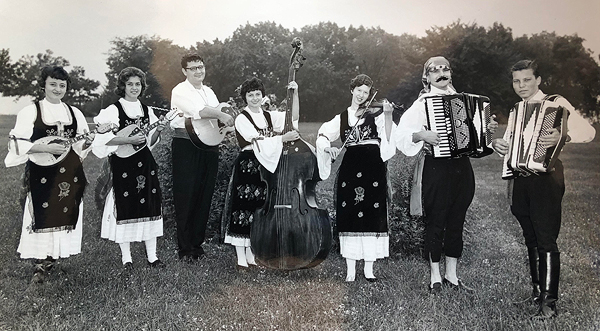
photo courtesy of the artists
Lifelong friend and band-mate Lenny Tepsich (percussion and ćelo) explains. “The [older players] would let you tag along and go play gigs with them. And that’s how they gave it to you. On the job training, that’s how you learned. And to this day... how we learned, we take it and lay the music in people’s laps.”
Fiddle player Mike Furjanic also grew up in a musical family. His parents had a band and his mother put a violin in his hand at the age of seven, telling him he would play. “I didn’t have a choice!” he says. He quit while he was in college, but found that something was missing and picked it up again. “Six, eight hours a day, Saturday... I’d just walk around the house playing for hours. It’s an obsession.”
Learning from your elders
That obsession was nurtured by a community passionate about its culture, especially its music. Lenny, Danilo and Mike all grew up in Steelton playing with master tamburaši such as the legendary George Caba (1922-2010) — a Romanian fiddle player who took them under his wing and into his mentorship.
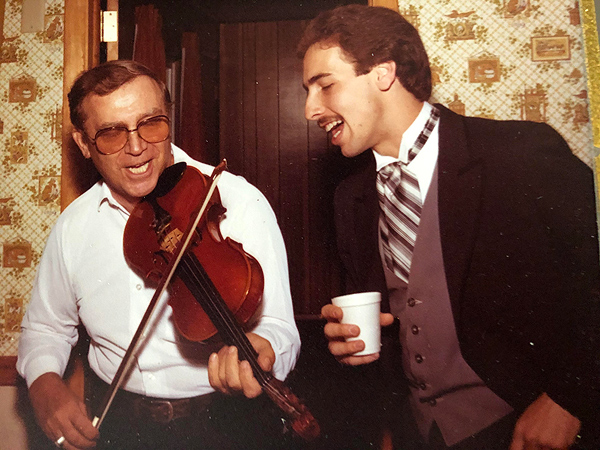
photo courtesy of Lenny Tepsich
Bass player Chris Radanovic also grew up in Steelton. But, as the youngest member of the group, he grew up listening to Sviraj. As Danilo notes, “That’s the tradition, that’s the folk tradition. You’re learning by ear.” George Caba was such an important influence that Sviraj dedicated their CD Zumba Zai to him. Included on that CD is an early cassette recording of George teaching them that song.
The population of Steelton had grown and diversified in the early 20th Century as immigrants from Eastern Europe came to work in the burgeoning steel mills. George Caba’s family came from a region in Romania that had a mix of ethnic groups from Serbia, Croatia, Romania, Bosnia and Macedonia. These same groups settled together in Steelton. So, it is no surprise that they found camaraderie in each other’s musical repertoire. They played together, and played for each other’s community events such as weddings, baptisms, dances, picnics, even funerals. Though as Danilo observes, no “occasion” is required; music happens whenever tamburaši are together in the same room.
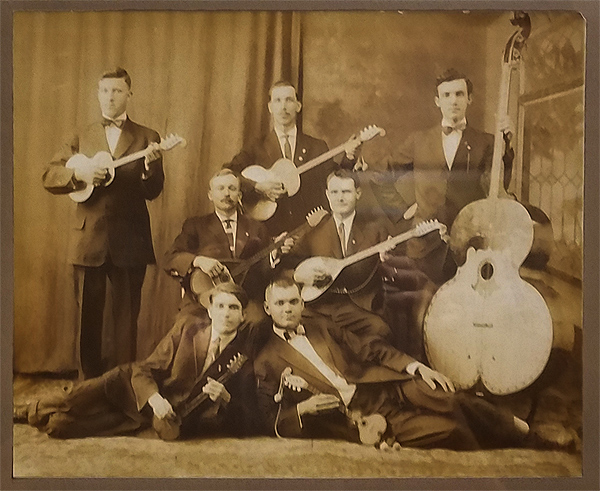
Tony Bukovac Filip Gruic Sam Pestelak
Andi Ferencak John Sugart
John Shiprak Milo Bogdanovich
The members of Sviraj remember John “Shippy” Shiprak teaching kids at the church to play tambura music. Mike says, "He took everyone under his wing."
Tambura music
This diversity continues in Sviraj. Band members are Serbian and Croatian, and their repertoire includes ballads, popular songs and kolo (line dance) music from throughout the Balkans. Rhythms range from 3 or 4 beats per measure, familiar in Western European music, to the more complex Eastern European rhythms that might be 7, 9 or 11 beats per measure.
Lenny says, “If you trace tambura in this country, you can trace it back to Steelton. That’s where it started.” Mike adds that the style played in Steelton is closer to the “real traditional tambura sound” because the musicians came directly from that region in Eastern Europe. In other communities, the sound has been altered by a lack of that kind of access. He explains that it has to do with where they position their strumming: the closer to the bridge, the more “twangy” and therefore, less traditional-sounding.
All it takes is for one person to teach it that way, and you have a whole generation of new musicians playing in that style. This is how traditions evolve and begs the question: what is “authentic” tambura music?
Understanding excellence
Danilo offers an important perspective on the question of authenticity and excellence. For him, and for the other members of Sviraj, authenticity is not so much about historical accuracy or a perfect rendition of the song. It is about community engagement. He says, “First of all, I wouldn’t even use the term authenticity, probably. It’s not...” [he pauses, searching for words...]
“Example: I was singing Zapevala Sojka Ptica — and it’s a sad song, a Bosnian Macedonian song — I remember singing it at the Macedonian church and [partway] through, one of the ladies, whom I know... turned to me and said in Serbian, ‘Dani, enough now,’ because she was crying to it. I’ll take that, anytime. I’ll take that. I could have been off key! But it was the emotion that was conveyed, both from her to me and, hopefully, from me to her. And that’s how I see excellence. I think for all of us it’s the feeling. It’s the connection between them and us and the culture . . . And this happened probably 25 years ago . . . But I can remember her turning to me... there were tears here [running down her cheeks]. Phshooooo. Okay. We came around to the end of the next phrase, and we stopped there. I’ll take that anytime.”
He continues, “As long as you take it that way, then the pressure is off. If you’re having a good time, you know? I play the best I can. I always try to sing the poetry, rather than the lyrics. It’s different. If you sing it how you feel it, then that’s the best you can do.” Mike elaborates on this: “It’s not just about us playing a song and you dance to it. It’s the whole culture; it’s one big thing . . . Nothing hits you in the stomach like our music.”
Play on!
In Serbo-Croatian, Sviraj means “play!” or “play on!” It isn’t a request; it is a command. As Danilo explains, “...That’s particularly what happens when you have a tamburaši group... Folks will just tell you to sviraj! Just to play. It’s because the music is fundamental to our traditions.”
In fact, folks expect to dance. Sometimes the group will take 15 or 20 minutes to play popular songs or to experiment with other tunes. But before long, someone will come up and say “Aren’t you guys gonna play any kolos today?”
As Danilo explained, “It’s not ‘Please.’ It’s ‘What good are you if you’re not gonna play any kolos?’ We say, ‘But we have these other couple of songs we wanted to play...’ No. Play. Sviraj. Play kolos.” So Sviraj has always played for dancing. They might arrive with a set list, but it often goes out the window. As Chris says, “When this band plays, people can’t sit still.” Mike adds, “A guy doesn’t go into a kolo because he wants to dance. He goes into the kolo to show the girls how good he can dance. Because he might be interested in a particular one over there, and that’s when the fancy footwork comes out.”
East or west, home is best
Although the band plays all over the country, for festivals as well as proscenium stages, Danilo says, “Beyond a doubt, the best place to play is in Steelton. And the reason for that is... the community. It’s really funny. You know the people in the kolo. You know the relationships. You know that this person dancing over here is a kum or kuma (godparent) of this person over here. You even know what tunes they like.”
The band is adept at changing on a dime. He tells several stories about the musicians switching up and playing a particular tune simply because an elder in the community entered the kolo. And, with a simple look from one of those elders, they know if they are playing too quickly or too slowly. That connection and those relationships are what motivate these men who have been playing for, and dancing with, this community since they were children.
“While we appreciate the other audiences, and they’re wonderful... when you walk into a place and you smell sarma (traditional stuffed cabbage) and sweet bread... That’s it. That’s just different. It’s different.”
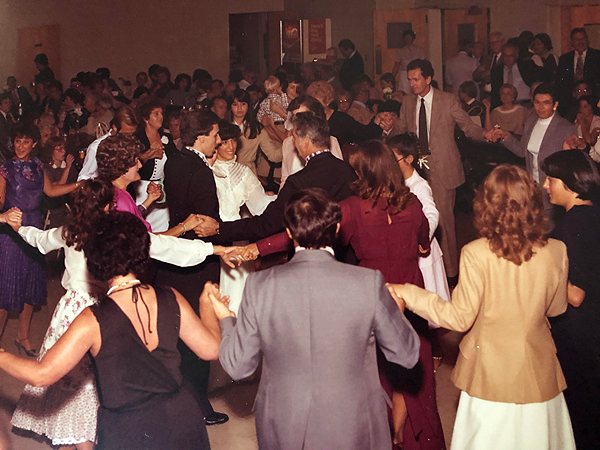
photo courtesy of Lenny Tepsich
Powerful bonds
When tamburaši play for a wedding, it isn’t only for dancing at the reception. They start out in someone’s home, playing for the bride and/or the groom as they’re getting dressed. Then they play around the bride’s car and in the church, when the bride and the groom get married. Then back out to the car so people can dance kolos around the car until the bride and groom leave. After that, they return to the hall and play for dancing until tomorrow morning. Danilo observes, “It’s not a typical gig.”
All the members of Sviraj play in other kinds of musical settings, outside of tamburaši, though none are professional musicians. According to Lenny, bands that rehearse break up. He says, “We don’t rehearse. That’s why we’ve stayed together so long. That’s the secret musicians want to talk about. You ask any band who has broken up and they’ll say they broke up at rehearsal.”
But this principle undergirds a larger truth. These tamburaši are so in sync with each other, that playing together is an extension of who they are. They were once playing for a non-Balkan crowd and someone asked for a waltz. Danilo made one up on the spot and the other tamburaši simply followed along. Thirty minutes later, the person asked them to play it again. They couldn’t remember what they had played so they created something else, on the spot. Danilo says, “You begin to trust your hands. If you have to think it out, that’s way too late. So you trust your hands and your ear... and you have to trust each other.”
Chris, the classically trained musician, confirms this. “As far as on stage and working as a group, these are the three best musicians I know. You feel it and you just know what they are going to do. He hits a chord and I know where he’s going and — we’re just locked in.” Lenny adds, “To be playing with cats that you love and you just can’t wait to do it again — you get butterflies just to go play the gig. But then you’re playing the gig and you have tears and chills just because that’s how good it is.”
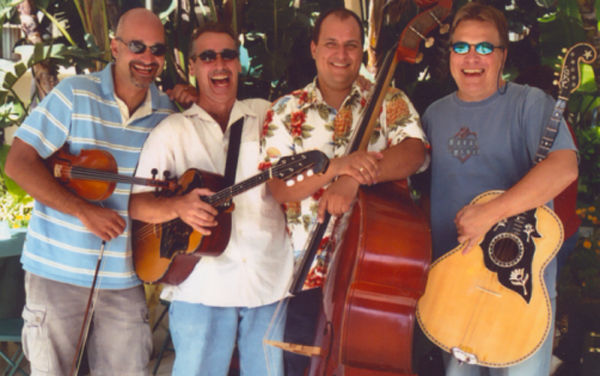
photo courtesy of the artists
Connected to the community
Not only do these musicians love playing together, their connection to the community creates a sense of responsibility that goes both ways. The community feels a sense of ownership of Sviraj, and the tamburaši feel such a deep connection to the community, that they can’t imagine not playing.
During the COVID pandemic in 2020, the Serbian church had to cancel its annual Serb Fest and picnic. Those two events bring Serbs home to Steelton from all over the country. Sviraj decided to set up outside the church and play for people as they drove by to pick up the traditional food they had ordered in advance.
When Sviraj was invited to submit a video of the performance to a virtual national gathering of tamburitza bands, they were told it was one of the most joyful performances the sponsors had seen. It was clear they were having a blast playing together.
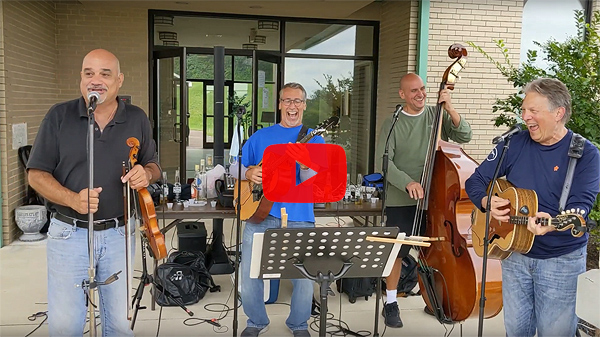
click to watch the video on YouTube
As Danilo explains, “You’re not this removed performer. You are not! You are part of it. Whether you’re playing, or whether you’re dancing or just listening, just sitting in the audience, you are part of it... That’s the thing: we’re all part of this.” Chris adds, “There are many [tambura orchestras] that sound better, but we bring an energy and an emotion and a joy to it that a lot of groups don’t do.”
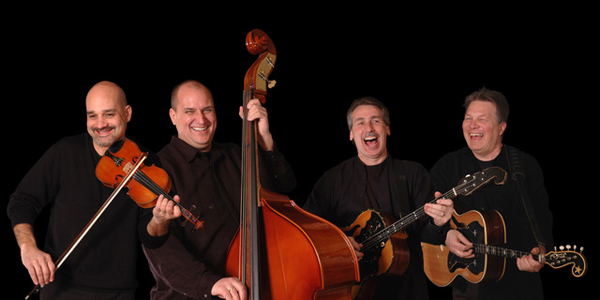
photo by C. Michael Hager
How to say it
- Sviraj is pronounced SVEE-rrye, with a rolled R. Non-native speakers can get closer to the correct pronunciation by saying "dye" rather than Americanizing to "rye."
The people:
- Danilo (Dani) Yanich — DAHN-ee-lohw (donny) YAH-nitch
- Lenny Tepsich — LEH-nee TEHP-sick
- Mike Furjanic — mike fur-DJAN-ick (like mechanic)
- Chris Radanovic — kriss ruh-DOHN-ah-vick
- George Caba — CAB-ah (starts like cabin)
The music:
- tambura — TOM-boorrr-ah (the R is rolled) — the musical genre
- tamburaši — TOM-bour-AH-she (the musicians)
- tamburitza — TOM-bour-RITZ-ah — a family of lute-like stringed instruments
- prim — prEEM — the high-voiced soprano of the tambura family
- bulgarija — boo-GAH-dee-uh — and again, a native speaker would roll the R — a rhythm instrument, similar to a guitar in size and voice, with five strings
- ćelo — TCHELL-oh (pronounced like the Western instrument: cello) — similar in size to bulgarija or guitar; tuned GDAE like a bass but an octave higher; suited to playing improvised countermelodies
- Zapevala Sojka Ptica — Zah-PEH-vuh-luh ZOY-ka pa-TEET-suh
- Zumba Zai — ZOOM-bah ZYE
The culture:
- kolo — KOH-loh (but "oh" leans toward "ah") — a traditional dance
- kolos — KOH-lohs (but "lohs" is almost "loss")
- kum or kuma — godfather / godmother / honorary family member
- sarma — traditional stuffed cabbage
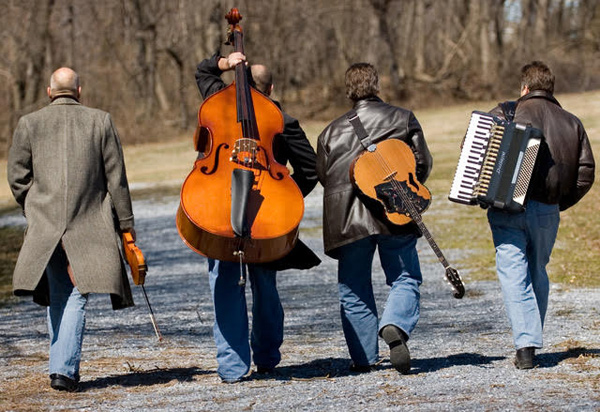
photo by C. Michael Hager



Brand icons for Facebook, YouTube, Instagram and other social media platforms are the trademark of their respective owners. No endorsement is implied.